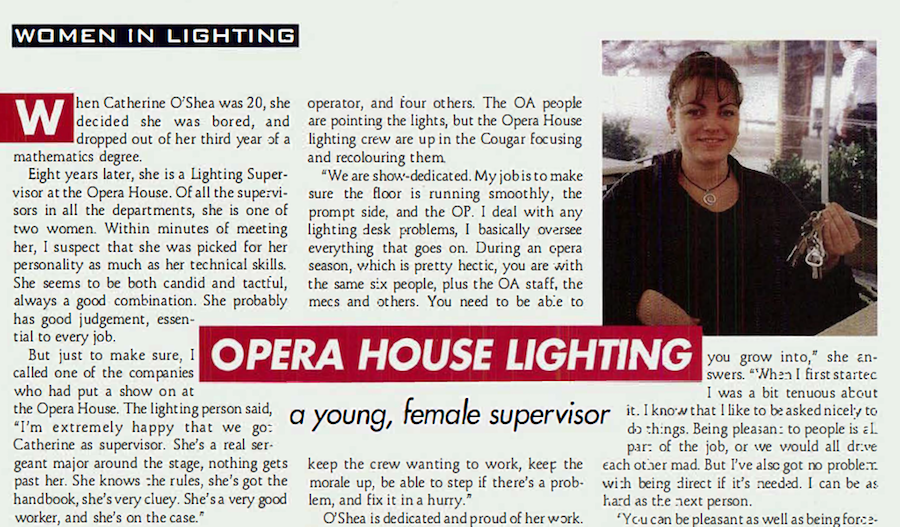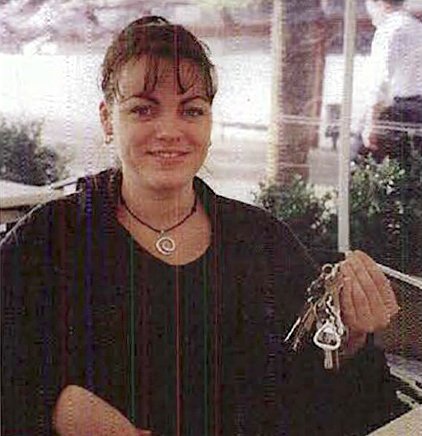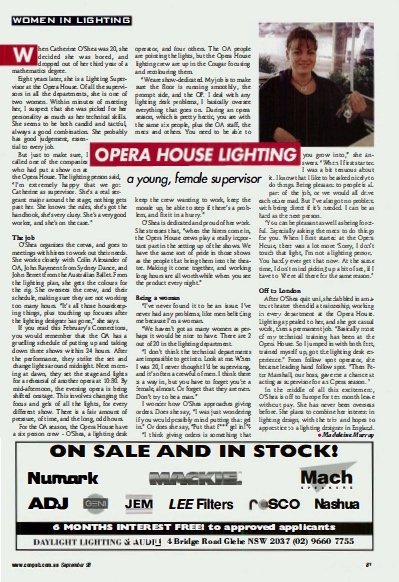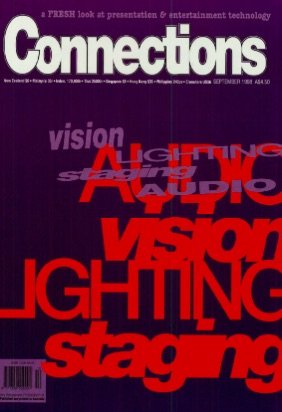News
4 Jan 2020
Opera House Lighting: Catherine O’Shea

Subscribe to CX E-News
Article from The Archive:
Connections Magazine, September 1998.
Women in Lighting
Opera House Lighting: Catherine O’Shea
When Catherine O’Shea was 20, she decided she was bored, and dropped out of her third year of a mathematics degree. Eight years later, she is a Lighting Supervisor at the Opera House.Of all the supervisors in all the departments, she is one of two women.
Within minutes of meeting her, I suspect that she was picked for her personality as much as her technical skills. She seems to be both candid and tactful, always a good combination.
She probably has good judgement, essential to every job. But just to make sure, I called one of the companies who had put a show on at the Opera House. The lighting person said, “I’m extremely happy that we got Catherine as supervisor. She’s a real sergeant major around the stage, nothing gets past her. She knows the rules, she’s got the handbook, she’s very cluey. She’s a very good worker, and she’s on the case.”
The job
O’Shea organises the crews, and goes to meetings with hirers to work out their needs. She works closely with Colin Alexander of OA, John Rayment from Sydney Dance, and John Berrett from the Australian Ballet.
From the lighting plan, she gets the colours for the rig. She oversees the crew, and their schedule, making sure they are not working too many hours. “It’s all those housekeeping things, plus touching up focuses after the lighting designer has gone,” she says.
If you read this February’s Connections, you would remember that the OA has a gruelling schedule of putting up and taking down three shows within 24 hours. After the performance, they strike the set and change lights around midnight.
Next morning at dawn, they set the stage and lights for a rehearsal of another opera at 10:30. By mid-afternoon, the evening opera is being shifted onstage. This involves changing the focus and gels of all the lights, for every different show. There is a fair amount of pressure, of time, and the long, odd hours.
For the OA season, the Opera House have a six person crew – O’Shea, a lighting desk operator, and four others. The OA people are pointing the lights, but the Opera House lighting crew are up in the Cougar focusing and recolouring them.
“We are show-dedicated. My job is to make sure the floor is running smoothly, the prompt side, and the OP. I deal with any lighting desk problems, I basically oversee everything that goes on.
“During an opera season, which is pretty hectic, you are with the same six people, plus the OA staff, the mecs and others. You need to be able to
keep the crew wanting to work, keep the morale up, be able to step if there’s a problem, and fix it in a hurry.”
O’Shea is dedicated and proud of her work. She stresses that, “when the hirers come in, the Opera House crews play a really important part in the setting up of the shows.
“We have the same sort of pride in those shows as the people that bring them into the theatre. Making it come together, and working long hours are all worthwhile when you see the product every night.”
Being a woman
“I’ve never found it to be an issue. I’ve never had any problems, like men belittling me because I’m a woman.
“We haven’t got as many women as perhaps it would be nice to have. There are 2 out of 20 in the lighting department.
“I don’t think the technical departments are impossible to get into. Look at me. When I was 20, I never thought I’d be supervising, and it’s often a crew full of men. I think there is a way in, but you have to forget you’re a female, almost. Or forget that they are men. Don’t try to be a man.”
I wonder how O’Shea approaches giving orders. Does she say, “I was just wondering if you would possibly mind putting that gel in.” Or does she say, “Put that f•••ing gel in!”?
“I think giving orders is something that you grow into,” she answers. “When I first started I was a bit tenuous about it. I know that I like to be asked nicely to do things.
“Being pleasant to people is all part of the job, or we would all drive each other mad. But I’ve also got no problem with being direct if it’s needed. I can be as hard as the next person.
“You can be pleasant as well as being forceful. Specially asking the mecs to do things for you. When I first started at the Opera House there was a lot more ‘Sorry, I don’t touch that light, I’m not a lighting person: You hardly ever get that now.
“At the same time, I don’t mind picking up a bit of set, if I have to. We’re all there for the same reason.”
Off to London
After O’Shea quit uni, she dabbled in amateur theatre then did a traineeship, working in every department at the Opera House. Lighting appealed to her, and she got casual work then a permanent job.
“Basically most of my technical training has been at the Opera House. So I jumped in with both feet, trained myself up, got the lighting desk experience.”
From follow spot operator, she became leading hand follow spot. “Then Peter Marshall, our boss, gave me a chance at acting as supervisor for an Opera season.”
In the middle of all this excitement O’Shea is off to Europe for ten month leave without pay. She has never been overseas before. She plans to combine her interest in lighting design, with the trip and hopes to apprentice to a lighting designer in England.
From Connections 58, September 1998.
Read more stories from this edition here
Subscribe
Published monthly since 1991, our famous AV industry magazine is free for download or pay for print. Subscribers also receive CX News, our free weekly email with the latest industry news and jobs.







